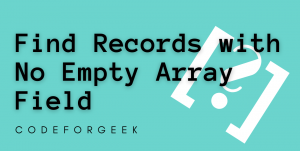In this tutorial, I will explain how to use the $setOnInsert operator in MongoDB.
The $setOnInsert operator simply inserts a field on an update operation when upsert is set to true and it results in an insert of a document. if the operation does not result in an insert of a document(s), then the $setOnInsert operator does not do anything.
This guide shall take you through several examples to explain how you can use the $setOnInsert operator in MongoDB.
The $setOnInsert Operator Syntax in MongoDB
Here’s what the syntax looks like of the $setOnInsert operator in the Mongo shell:
db.collection.update(
query,
{ $setOnInsert: { field1: value1, ... } },
{ upsert: true }
)
To insert an embedded or nested document, we can use the dot notation in MongoDB. You can use the $setOnInsert operator with the upsert option as true with different update operation functions like update(), updateMany(), and findAndModify().
Using the $setOnInsert Operator in MongoDB
Let us get started with our examples to learn to use this operator in MongoDB from the mongo shell.
Inserting a Document Using the $setOnInsert Operator in MongoDB
We now insert a regular document inside a collection.
- Start the MongoDB local database server
- Choose the database you want to use in the mongo shell and navigate into it using the use database_name command
- I am using the randomCollection collection which is totally empty right now. I will first insert a document inside it although you choose not to:
> db.randomCollection.insertOne({
... "name" : "Katherine",
... "age" : 3,
... "breed" : "Persian Cat",
... "personality" : {
... "dogFriendly" : true,
... "childFriendly" : true
... }
... })
{
"acknowledged" : true,
"insertedId" : ObjectId("6172f11a0bcd9f2d53f6a355")
}
- Checking if the cat document has been added:
> db.randomCollection.find().pretty()
{
"_id" : ObjectId("6172f11a0bcd9f2d53f6a355"),
"name" : "Katherine",
"age" : 3,
"breed" : "Persian Cat",
"personality" : {
"dogFriendly" : true,
"childFriendly" : true
}
}
- I will now query for a document that does not exist in our collection and set upsert as true. I am also using the $set operator here:
> db.randomCollection.update(
... { name: "Bella" },
... {
... $set: { age: 5 },
... $setOnInsert: { breed: "Scottish Fold Cat" }
... },
... { upsert: true }
... )
WriteResult({
"nMatched" : 0,
"nUpserted" : 1,
"nModified" : 0,
"_id" : ObjectId("6172f3a91a205e9b1fb741ea")
})
The operation seems successful as the WriteResult shows nUpserted as 1.
- Let us see if our document is added:
> db.randomCollection.find().pretty()
{
"_id" : ObjectId("6172f2fa0bcd9f2d53f6a356"),
"name" : "Katherine",
"age" : 3,
"breed" : "Persian Cat",
"personality" : {
"dogFriendly" : true,
"childFriendly" : true
}
}
{
"_id" : ObjectId("6172f3a91a205e9b1fb741ea"),
"name" : "Bella",
"age" : 5,
"breed" : "Scottish Fold Cat"
}
Using $setOnInsert Operator for Embedded or Nested Documents
I am now using the $setOnInsert operator to insert embedded or nested documents in our collection.
> db.randomCollection.update(
... { name: "Fiona" },
... {
... $set: { age: 8 },
... $setOnInsert: { breed: "Siberian Cat", "personality.dogFriendly" : true }
... },
... { upsert: true }
... )
WriteResult({
"nMatched" : 0,
"nUpserted" : 1,
"nModified" : 0,
"_id" : ObjectId("6172f5031a205e9b1fb741f3")
})
- Let us check how our document now looks:
> db.randomCollection.find().pretty()
{
"_id" : ObjectId("6172f2fa0bcd9f2d53f6a356"),
"name" : "Katherine",
"age" : 3,
"breed" : "Persian Cat",
"personality" : {
"dogFriendly" : true,
"childFriendly" : true
}
}
{
"_id" : ObjectId("6172f3a91a205e9b1fb741ea"),
"name" : "Bella",
"age" : 5,
"breed" : "Scottish Fold Cat"
}
{
"_id" : ObjectId("6172f5031a205e9b1fb741f3"),
"name" : "Fiona",
"age" : 8,
"breed" : "Siberian Cat",
"personality" : {
"dogFriendly" : true
}
}
Using the $setOnInsert Operator on Documents that Exist in MongoDB
Let us try to use the $setOnInsert operator on a document that exists, I am not using the $set operator this time.
> db.randomCollection.update(
... { name: "Fiona" },
... {
... $setOnInsert: { "personality.childFriendly" : true }
... },
... { upsert: true }
... )
WriteResult({ "nMatched" : 1, "nUpserted" : 0, "nModified" : 0 })
The nMatched shows 1 however, the nUpserted and nModified values show 0.
- Let us check our collection for the last time now:
> db.randomCollection.find().pretty()
{
"_id" : ObjectId("6172f2fa0bcd9f2d53f6a356"),
"name" : "Katherine",
"age" : 3,
"breed" : "Persian Cat",
"personality" : {
"dogFriendly" : true,
"childFriendly" : true
}
}
{
"_id" : ObjectId("6172f3a91a205e9b1fb741ea"),
"name" : "Bella",
"age" : 5,
"breed" : "Scottish Fold Cat"
}
{
"_id" : ObjectId("6172f5031a205e9b1fb741f3"),
"name" : "Fiona",
"age" : 8,
"breed" : "Siberian Cat",
"personality" : {
"dogFriendly" : true
}
}
Read More: $nin Operator in MongoDB: Comprehensive 2021 Guide
Conclusion
In this article, we learned how to use the $setOnInsert operator in MongoDB.





